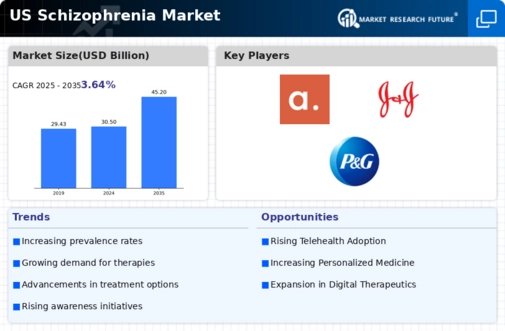Innovative Drug Development
The schizophrenia market is significantly influenced by the ongoing innovation in drug development. Pharmaceutical companies are increasingly investing in research and development to create novel antipsychotic medications that offer improved efficacy and reduced side effects. Recent advancements in pharmacogenomics and personalized medicine are paving the way for tailored treatment approaches, which may enhance patient outcomes. The introduction of long-acting injectable formulations is also noteworthy, as they can improve adherence to treatment regimens. The market for schizophrenia therapeutics is projected to reach approximately $10 billion by 2027, reflecting the potential for new drugs to capture market share and address unmet medical needs.
Government Initiatives and Funding
Government initiatives and funding play a pivotal role in shaping the schizophrenia market. Various federal and state programs aim to enhance mental health services, including those specifically targeting schizophrenia. Increased funding for research initiatives, such as the National Institute of Mental Health (NIMH), supports the exploration of new treatment modalities and interventions. Additionally, policies promoting mental health awareness and access to care are likely to drive market growth. The allocation of resources towards mental health services is expected to rise, with estimates indicating a potential increase of 15% in funding over the next five years, thereby positively impacting the schizophrenia market.
Rising Prevalence of Schizophrenia
The increasing prevalence of schizophrenia in the US is a critical driver for the schizophrenia market. Recent estimates suggest that approximately 1% of the population is affected by this disorder, translating to around 3.5 million individuals. This growing patient population necessitates the development and availability of effective treatment options, thereby stimulating market growth. As awareness of mental health issues rises, more individuals are likely to seek diagnosis and treatment, further expanding the market. The schizophrenia market is expected to experience a compound annual growth rate (CAGR) of around 4.5% over the next few years, driven by the need for innovative therapies and support services for this demographic.
Increased Focus on Mental Health Awareness
The heightened focus on mental health awareness in the US is a significant driver for the schizophrenia market. Public campaigns and advocacy efforts are aimed at reducing stigma associated with mental health disorders, encouraging individuals to seek help. This cultural shift is likely to lead to earlier diagnosis and treatment of schizophrenia, which can improve long-term outcomes for patients. As awareness increases, the demand for mental health services, including those specifically for schizophrenia, is expected to rise. Market analysts predict that the overall mental health market could expand by approximately 25% in the next five years, with a substantial portion attributed to the growing recognition of schizophrenia as a serious health concern.
Technological Advancements in Treatment Delivery
Technological advancements are transforming the delivery of treatment within the schizophrenia market. The integration of telemedicine and digital health platforms is facilitating remote consultations and monitoring, which can enhance patient engagement and adherence to treatment plans. These technologies are particularly beneficial for individuals in underserved areas, where access to mental health professionals may be limited. Furthermore, mobile applications designed for symptom tracking and management are gaining traction, providing patients with tools to better manage their condition. The adoption of these technologies is expected to grow, potentially increasing the market size by 20% over the next few years as more patients and providers embrace these innovative solutions.














Leave a Comment